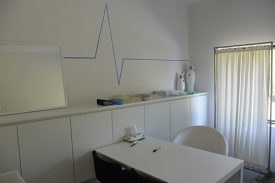A facelift is an operation by which folds and wrinkles of the facial skin are tightened, mostly in combination with the subcutaneous tissues. When there is excess fat under the chin or when there are thick skin folds in the neck, it might be necessary to lift these too. A facelift does not affect frown wrinkles or wrinkles around the mouth or eyelids. If you want these last wrinkles to disappear, you will have to take another treatment.
Facelift is a surgery which makes you feel good and which makes your face shine. It is indeed a cosmetic procedure but moreover it is an art. It is a treatment which demands a quality result. Therefore a team of professional experts and an extensively skilled plastic surgeon will help you.
S-lift/ Mini-facelift
Nowadays a mini-facelift is a popular procedure, which is less complicated than the traditional facelift.
With this technique the oval shape of the face can be re-designed without freeing the skin in the extent that it is done in case of a traditional facelift. It’s vital to realise that it isn’t the skin which ages first but the skin and the subcutaneous muscle in total.
Ageing of the lower part of the face always starts with slackening of the tissues at this level. In case of a mini-facelift, the slackening of the middle and lower part of the face are treated.
The mini-facelift is performed under a local anaesthetic. The plastic surgeon makes an incision in the hair, at the temple, above the ear. The scars occur inside and behind the ear, so you can still have your hair cut short or wear it to the back. The skin of the face is tightened (not of the neck) to create an harmonious effect and a natural rejuvenation of the face. In case of hanging cheeks, a micro-sculpture is performed at the same time.
Neck lift
This involves a lift of the neck region. In case of this operation the scars go more backwards than in case of a S-lift, this means to the backside of the ear and in the neck hairline, to create a maximal result of the neck skin. Sometimes also an incision is made to remove the subcutaneous tissue and to pull the connective tissue and muscle tissue more tightly together.
Full-facelift
In case of this procedure, fat and skin tissue is removed from the middle part of the face to and with the neck, and muscles are shortened. Therefore the cosmetic surgeon makes an incision from the hairline above the temple, via the natural fold in front of and behind the ear to the backside of the head. The skin is then released from the tissues and muscles. Excess fat is removed and muscles are shortened. The skin is laid back and tightened and the excess skin tissue is removed. Sutures are made in different layers, to divide the pulling power of the skin. If desired, an incision is made in the fold under the chin as well to tighten the front neck muscles.
Brow lift / forehead lift
This procedure corrects drooping brows and improves the lines and furrows of the front head skin. Although the brows and forehead form a whole with the face, this operation is usually performed separately and is not the same as a full facelift. This operation is often performed in combination with an upper eyelid or lower eyelid correction.
Before the forehead lift, you will have a prior consultation with the plastic surgeon. When you take medicines, you should tell the doctor. Certain medicines (like aspirin or APC and the like) can not be taken ten days before the operation. Next to this you should quit smoking four weeks before the plastic surgery.
Smoking narrows the blood vessels and this can cause wound disturbances or even wound necrosis after the forehead lift.
Following the facelift, your face will be supported by an elastic hat. This is a kind of bandage which cannot be removed within the first 5 to 7 days. After the operation, your face and neck will be swollen and discoloured. This lasts two weeks on average but generally you will have no other complaints or pain.
Sutures will be removed 1 to 2 weeks after the operation. A facelift brings the same risks as any other procedure. There is a risk of post-operative bleeding and infection. In some cases a facial nerve might temporarily be disconnected and cause some paralysis like a drooping mouth corner or incapability of completely closing the eyelids. Luckily, these severe complications hardly ever occur. Following the facelift there might occur some local oedema or stiff places in the face as well. These will automatically disappear but you can also have them treated by a beauty specialist or a skin therapist. In case you have a dark skin, scars of the facelift might be more visible. To cover these scars, you need permanent camouflage.
The definite result of a facelift is only to be seen after a few weeks.
In case of detailed inspection, scars are indeed always conspicuous, but actually they will usually be barely perceptible.
The effect of a facelift will usually maintain ten years. After that, you might need a new facelift.
A facelift involves smoothening and tightening of the skin, but wrinkles in your face which are created by the way you smile or talk, won’t disappear. These lines or wrinkles are part of the facial expression and will always maintain. Also lines around the mouth or eyelids won’t disappear. Therefore you will need additional treatment.
You can discuss this with the plastic surgeon and ask what might be the most suitable treatment for you.
You should notice as well that the natural ageing process of the skin is not stopped by a facelift. After the operation the skin will gradually lose its elasticity, just like before.
















